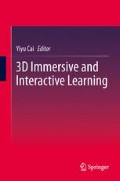Abstract
There is an emerging trend that the virtual learning system (VLS) has the ability to help learners learn better. With the increased immersion, interaction , and imagination that a three-dimensional (3D) VLS provides, it acts as an effective learning platform to ease teaching and learning problems especially for students who are academically at risk. This study investigates what features are needed in a 3D VLS to motivate learning for the topic on Digestion for Secondary 1 Normal (Technical) students in Singapore. Furthermore, it also explores how learning in the 3D VLS affects students’ attitudes and achievements. Observations would also be made to see if the students have gained any twenty-first century skills such as self-directedness and collaboration. It was found that students gained an average of seven marks in their posttest, and that tasks that were collaborative in nature led to increased student academic efficacy. Findings also suggest that 3D simulation games accompanied with Twitter made the difference in motivating the students best as compared to the other features in the VLS as students were motivated to be engaged in more academic discussions. The authors also noted a slight improvement in students’ self-management skills and analytical thinking, which suggests that the VLS helps to promote the development of essential twenty-first century skills.
Access this chapter
Tax calculation will be finalised at checkout
Purchases are for personal use only
References
Ministry of Education (2000) Report of the committee on compulsory education in Singapore
Luke A, Freebody P, Lau S, Gopinathan S (2005) Towards research-based innovation and reform: Singapore schooling in transition. Asia Pac J Educ 25(1):5–27
Albright J, Heng MA, Harris K (2008) Pedagogical change in the normal technical classroom. Centre for research in pedagogy and practice research reports. http://repository.nie.edu.sg/jspui/bitstream/10497/4157/3/CRP26_05JA_FinalResRpt
New Media Consortium and EDUCAUSE Learning Initiative (2007). The horizon report: 2007 edition. http://www.nmc.org/publications/2007-horizon-report
Wann I, Mon-Williams M (1996) What does virtual reality NEED?: human factors issues in the design of threedimensional computer environments. Int J Hum-Comput Stud 44:829–847
Jacobson MJ (2006). Empirical research into learning in 3D virtual and game environments: selected review of the literature [working paper]. Learning Sciences Laboratory, National Institute of Education, Nanyang Technological University, Singapore
Clarke J, Dede C, Ketelhut DJ, Nelson B (2006) A design-based research strategy to promote scalability for educational innovations. Educ Technol 46(3):27–36
Clarke J, Dede C (2005) Making learning meaningful: An exploratory study of using multi-user environments (Muves) in middle school science. The annual meeting of the American Educational Research Association, Montreal
Dede C, Ketelhut D (2003) Motivation, usability, and learning outcomes in a prototype museum-based multi-user virtual environment. Annu Meet Am Educ Res Assoc, Chicago
Norton C, Corbit M, Greene E, Ormaechea L (2008). A comparison of self-directed learning in a virtual world environment to traditional science teaching methods. Paper presented at the NARST 2008 Annual Meeting, Baltimore, MD
Conceic¸a˜o-Runlee S, Daley BJ (1998). Constructivist learning theory to web-based course design: an instructional design approach. In Proceedings of the 17th annual midwest research-to-practice conference in adult, continuing and community education
Atkinson RC, Shiffrin RM (1968) Chapter: Human memory: a proposed system and its control processes. Psychol Learn Motivation 2:89–195
Gee JP (2003) What videogames have to teach us about learning and literacy. Palgrave Macmillan, New York
Buchanan K (2003) Opportunity knocking: co-opting and games. Assoc Learn Technol Newsl 43:10–11. http://www.alt.ac.uk/docs/ALT43web.pdf
Ricci K, Salas E, Cannon-Bowers JA (1996) Do computer-based games facilitate knowledge acquisition and retention? Mil Psychol 8(4):295–307
Kaptelin V, Cole M (2002). Individual and collective activities in educational computer game playing. In: Kosmann T, Hall R, Miyake N (eds)
Garris R, Ahlers R, Driskell JE (2002) Games, motivation, and learning: a research and practice model. Simul Gaming 33(4):441–467
Feller B (2006) Group: video games can reshape education. http://www.msnbc.msn.com/id/15309615/ns/technology_and_science-games
Steinkuehler CA (2004). Learning in massively multiplayer online games. In: Kafai YB, Sandoval WA, Enyedy N, Nixon AS, Herrera F (eds) Embracing diversity in the learning sciences: proceedings of the sixth international conference of the learning sciences (ICLS’04), Lawrence Erlbaum, Mahwah, New Jersey. pp 521–528
Hughes A (2009). Higher education in a Web 2.0 world. Bristol, England: JISC. http://www.jisc.ac.uk/media/documents/publications/heweb20rptv1.pdf
Freita S, Griffiths M (2008) The convergence of gaming practices with other media forms: what potential for learning? A review of the literature. Learning, Media Technol 33(1)
Eberhardt DM (2007) Facing up to facebook. About Campus 12(4):18–26
Lave J, Wenger E (1991) Situated learning: legitimate peripheral participation. Cambridge University Press, Cambridge
Ajjan H, Hartshorne R (2008) Investigating faculty decisions to adopt Web 2.0 technologies: theory and empirical tests. Internet High Educ 11(2):71–80
Yang SJH, Chen IYL (2008) A social network-based system for supporting interactive collaboration in knowledge sharing over peer-to-peer network. Int J Hum Comput Stud 66(1):36–50
Mason R (2006). Learning technologies for adult continuing education. Stud Continuing Educ 28(2):121–133
Selwyn N (2007). Screw blackboard…do it on Facebook: An investigation of students educational use of Facebook. Presented at the Poke 1.0 –Facebook Social Research Symposium, University of London
Dalgarno B, Lee MJW (2010) What are the learning affordances of 3D virtual environments. British J Educ Technol 41(1):10–32
Acknowledgments
The researchers wish to express their deepest gratitude and warmest appreciation to Dr Cai Yiyu and team at Nanyang Technological University and the management, Science and Information Technology departments from Jurong West Secondary School, in particular Mr Gan Chee Hau, Mdm Lock Lai Mun, and Mr Yip Hoe Yin for their support in making this research possible.
Author information
Authors and Affiliations
Corresponding author
Editor information
Editors and Affiliations
Rights and permissions
Copyright information
© 2013 Springer Science+Business Media Singapore
About this chapter
Cite this chapter
Wang, C.J., Low, A.S.L., Woo, C.S. (2013). 3D System for Learning Gains in the Lower Secondary Normal (Technical) Stream . In: Cai, Y. (eds) 3D Immersive and Interactive Learning. Springer, Singapore. https://doi.org/10.1007/978-981-4021-90-6_7
Download citation
DOI: https://doi.org/10.1007/978-981-4021-90-6_7
Published:
Publisher Name: Springer, Singapore
Print ISBN: 978-981-4021-89-0
Online ISBN: 978-981-4021-90-6
eBook Packages: Humanities, Social Sciences and LawEducation (R0)

